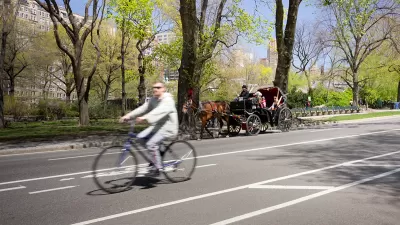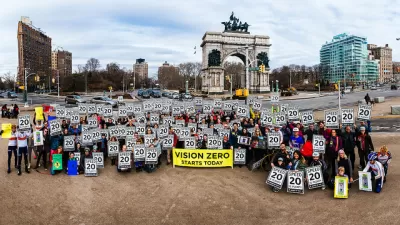Vision Zero has tragically failed 17 people on bikes in New York City this year, and Mayor Bill de Blasio couldn't stick with the status quo any longer.

A spate of cyclist fatalities in New York City inspired city officials to announce a large new bike infrastructure and traffic safety program whit week, reports Willie Hu.
The tragedies leading up to the announcement need to be respected. Hu starts the story of thusly:
Things could not get much worse in early July after three cyclists were killed in just over a week on the streets of New York City.
But they did. Two more cyclists were hit and killed on Tuesday — one in Brooklyn and another on Staten Island — and another struck on Wednesday morning in Queens was reportedly in critical condition.
That brings the year's total to 17—already seven more deaths than 2018. In response to growing pressure from advocates, Mayor Bill de Blasio, also a candidate for president, announced a $58.4 million bike safety plan, called the Green Wave [pdf]. The Green Wave plan "will try to make cycling safer by rapidly installing more protected bike lanes, redesigning intersections to make turns safer for cyclists and hiring 80 new city transportation workers dedicated to bike improvements," writes Hu.
"Under the new plan, the city will increasingly focus on creating a citywide network of protected bike lanes; currently the city has 1,243 miles of bike lanes, of which 480 miles are protected, meaning barriers physically separate cyclists from vehicles," adds Hu.
Earlier in the year, a single death by a cyclist on a rented bike in San Francisco inspired that city to remove on-street parking and create a protected bike lane on Howard Street. Perhaps every city has its limits. More coverage on New York's Green Wave plan is available in a separate article by Amanda Luz Henning Santiago.
FULL STORY: After 17 Cyclists Die, New York City Makes $58.4 Million Plan

Alabama: Trump Terminates Settlements for Black Communities Harmed By Raw Sewage
Trump deemed the landmark civil rights agreement “illegal DEI and environmental justice policy.”

Planetizen Federal Action Tracker
A weekly monitor of how Trump’s orders and actions are impacting planners and planning in America.

Why Should We Subsidize Public Transportation?
Many public transit agencies face financial stress due to rising costs, declining fare revenue, and declining subsidies. Transit advocates must provide a strong business case for increasing public transit funding.

Understanding Road Diets
An explainer from Momentum highlights the advantages of reducing vehicle lanes in favor of more bike, transit, and pedestrian infrastructure.

New California Law Regulates Warehouse Pollution
A new law tightens building and emissions regulations for large distribution warehouses to mitigate air pollution and traffic in surrounding communities.

Phoenix Announces Opening Date for Light Rail Extension
The South Central extension will connect South Phoenix to downtown and other major hubs starting on June 7.
Urban Design for Planners 1: Software Tools
This six-course series explores essential urban design concepts using open source software and equips planners with the tools they need to participate fully in the urban design process.
Planning for Universal Design
Learn the tools for implementing Universal Design in planning regulations.
Caltrans
Smith Gee Studio
Institute for Housing and Urban Development Studies (IHS)
City of Grandview
Harvard GSD Executive Education
Toledo-Lucas County Plan Commissions
Salt Lake City
NYU Wagner Graduate School of Public Service





























